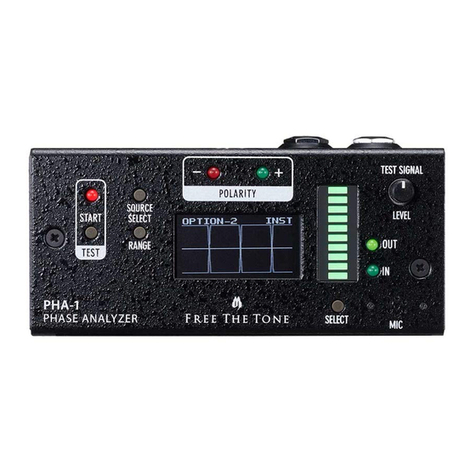
Turn on the power to the PHA-1, ARC-4, and your effects unit(s).
Turn the TEST SIGNAL LEVEL knob fully counterclockwise so that
the test signal will not be output.
1. Press the SOURCE SELECT switch until “OPTION-2” is shown in
the top line of the Display.
2. Press the TEST switch to select the measurement mode to be
used. Measurement modes switch each time when the TEST
switch is held pressed for about 1 second.
Two Types of Phase Measurements and PhaseJudgement Principle p.5
3. Recall the desired ARC-4’s preset.
By putting the ARC-4 in Direct mode and turning on the
loops one by one, it is possible to check the phase of each
effects unit.
4. Slowly turn the TEST SIGNAL LEVEL knob clockwise. The
waveform and level of the signal fed into the PHA-1.
Adjust the TEST SIGNAL LEVEL knob so that 4 to 9 LEDs of the
level meter illuminate.
Adjusting Signal to be Measured p.6
5. To set the device in the reversed phase from the phase
judgement result, turn on the ARC-4’s Phase Invert function
and save the setting in a preset.
NOTE
If the recalled combination of effects units contains a delay or reverb
unit, set the effect sound to minimum and perform the measurement.
Measuring Phase of Effects Unit Connected to ARC-4
Notes on Level Meter Display
Precautions for Battery Use
Optional Cable RC-7
The PHA-1 can be driven by a 9-volt battery. When the Display
shows “Low-Battery,” replace the battery with a new one. If
the PHA-1 is not used for a long period of time, remove the
battery and store them separately.
Placing the level shown at the upper rightcornerofthe Display
as the reference(0dB), each LED element of the level meter
illuminates when thesignal level reaches the corresponding level.
For example, if “-10dBm” is shown at the upper right corner
of the Discplay, the 7th LED (reference)
illuminates when the signal level exceeds
-10 dBm. Similarly for “-22dBm,” the
7th LED illuminates when the signal level
exceeds -22 dBm.
10 (Top)
9
8
7 0dB
6 -1dB
5 -3dB
4 -5dB
3 -7dB
2 -10dB
1 (Bottom) -20dB
+3dB
+2dB
+1dB
8
<< Repeated Pulse Measurement Mode >>
Example 1: “Over-Level” message
appears because the input signal
level is too high. Adjust the level
so that the “Over-Level” message
disappears and 4 to 9 LEDs of the
level meter illuminate.
Example 2: The phase is judged
properly but the input signal
waveform is truncated. To show the
whole waveform, switch the input
level range. Alternatively, decrease
the test signal output level or the
device’s output level to lower the
signal level fed to the PHA-1.
Example 3: The input signal level is
too low and the Display shows “Low-
Level.” Adjust the level sothat the
“Low-Level” message disappears and
4 to 9 LEDs ofthelevel meterilluminate.
If no level meter’s LED illuminates,
confirm whethertheconnection is
properly done and the power to the
subject deviceis turned on.
Example 4: The signal level is
properly adjusted and the incoming
signal’s entire waveform is displayed.
<< Continuous Measurement Mode >>
Example 1: The input signal level
is too high and all of the level meter
LEDs illuminate. Adjust the level so
that 4 to 9 LEDs of the level meter
illuminate.
Example 2: The input signal level is
too low and the Display shows “Low-
Level.” Adjust the level so that the
“Low-Level” message disappears
and 4 to 9 LEDs of the level meter
illuminate.
Example 3: The signal level is
properly adjusted and the incoming
signal’s entire waveform is displayed.
In this example, the shape of the
waveform fed into the PHA-1 differs
from that of the test waveform.
Please note that this is because that
the test waveform has been effect-
processed by the subject device and
is not a malfunction or failure.
Examples of Measurement Results
9
























